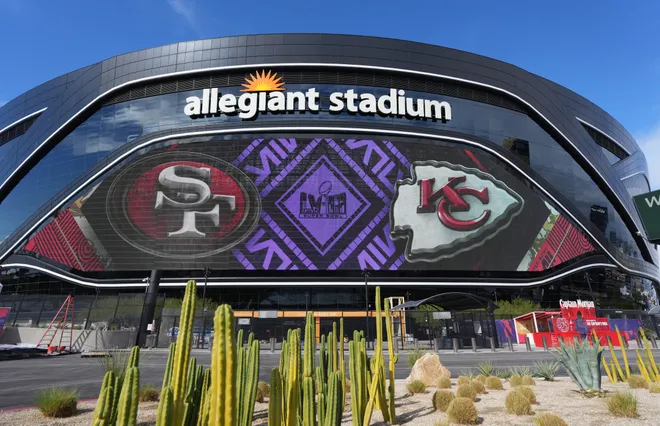Super Bowl 58 to be the first fully powered by renewable energy

This year's Super Bowl will be the first one fully powered by renewable energy, thanks to the host stadium's agreement with a solar farm, reports say.
More than 621,000 solar panels found in a barren area of the Nevada desert help power the Allegiant Stadium, home to the Las Vegas Raiders and host of Super Bowl LVIII, reports several media outlets.
According to the stadium's website, it's 100% "powered by by Nevada-sourced renewable energy."
According to CBS News, the Les Vegas stadium entered into a 25-year agreement with NV Energy to buy power from its new solar installation.
Doug Cannon, CEO of NV Energy, told CBS the solar panel installation produces enough to power 60,000 homes.
For an event like the Super Bowl, the solar panels must produce 10 megawatts, which is enough to power 46,000 homes.
Is renewable energy reliable, or will the power shut down mid-game?
According to the US Energy Information Administration, over 20% of the U.S.'s electricity came from renewable energy in 2022.
Solar power is very dependent on sunlight. So, it may not be the best option for cities with little sunlight. However, Forbes reports that some of the best solar panels can still be energy efficient despite constant cloudy days.
Luckily, the Nevada desert gets sunlight about 300 days a year.
"People sometimes get nervous about renewable power because they're not sure if it's going to be reliable," said U.S. Secretary of Energy Jennifer Granholm, who inspected the stadium's main electrical entry room, reports CBS News. "The fact that renewable power can power a facility like this reliably should speak volumes about what could happen in other communities."
A sustainable stadium
The stadium has also implemented other sustainability initiatives.
"Sustainability was top of mind during the construction process of Allegiant Stadium," says the stadium's website.
According to the webpage, its roof, which is made from ethylene tetrafluoroethylene, or ETFE, a recyclable plastic material that provides climate adaptability, insulation performance, self-cleaning, and a long lifespan, is one of its more energy-efficient features.
It also has a way of taking care of food scraps so they don't end up in landfills.
The website states that it collects an average of 12,000 pounds of kitchen cuttings and food scraps after each event. It then donates them to local live stock farms and used to feed the animals.
This isn't the first time a host stadium tries to curb the amount of waste it produces.
In 2020, the last time the Kansas City Chiefs faced the San Francisco 49ers in Miami, the Hard Rock Stadium tried to go zero waste by making sure all of its waste ended up at a recycling center, compost facility, or a plant where it was burned for energy, reports National Geographic.

Disclaimer: The copyright of this article belongs to the original author. Reposting this article is solely for the purpose of information dissemination and does not constitute any investment advice. If there is any infringement, please contact us immediately. We will make corrections or deletions as necessary. Thank you.







